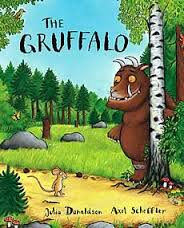Inspiring Young Readers
 posted on 08 Sep 2015
posted on 08 Sep 2015
The Gruffalo Effect
I recently did a book reading event as part of a community day at Newman University and selected one classic children's picture book to read every half hour. By far the most well attended and successful session was The Gruffalo written by Julia Donaldson and illustrated by Alex Scheffler. This simple story about a mouse outwitting a scarey creature in the forest and thus gaining confidence and subsequent status with the other creatures he meets along the way has a huge reputation, but I'm not a big fan of it myself. I'm not quite sure why this is because it is tightly written with a clear repetitive pattern and clear, colourful pictures. I guess that my personal aesthetic taste usually favours more subtle and complex stories and I also can't help thinking that Maurice Sendak gave us far more convincing and compelling mythical creatures in Where the Wild Things Are ( plus his drawing is astounding, as I'm sure Sheffler would agree). On the other hand, I also put WWTA on the menu of books to read aloud at the event and actually found that it was much more difficult to convey the rhythm and power of the words and illustrations when reading it to a group.
At the allotted Gruffalo time, children of all ages and their families poured enthusiastically into the session and the numbers grew while I was reading until the room was bursting at the seams with people standing at the back. Many joined in with what was evidently a very familiar and well loved story. The tension built as we waited for the point at which the Gruffalo first appears in the story and when he did, there were audible gasps. Parents and grandparents were smiling fondly throughout, little children were leaning forward with anticipation and a baby stared fixedly at the brightly coloured pictures. Everyone clapped at the end and several people thanked me. I have rarely had such an engrossed and appreciative audience.
I have always enjoyed reading books to children and their families and hope that I do it reasonably well, but I have a confession: I have never read this book aloud to a group before as it was published after my time in the classroom. I had read the book to myself of course and keep it on my shelves with my other books by this author, but not looked at it for a while so this was a bit of a risky new adventure for me. After all, when I trained as a teacher, we were always told to become very familiar with a book that we intended to use with children. We apparently needed to identify the key moments, be prepared how to pace the story, anticipate questions and learning opportunities throughout and at the end in order to exploit it fully and sear it in the memories of our pupils. I gather that this forward planning and intense analytical approach has become even more prevalent in recent times. It seems that it is not enough for children to bathe in a glorious story as an enjoyable activity in itself because stories in schools are now too often tied into achieving various targets and links to other curriculum areas. I am also shocked to learn that many schools do not include story time as a daily experience due to lack of time. It is now too often pushed to the margins instead of being a central entitlement for children at school. I do know that The Gruffalo is an 'approved' text in educational settings for the under fives and in schools partly because it easily lends itself to the necessary detailed analysis.
But it hadn't been spoilt for me in this way and so for the first time ever, most of my audience was ahead of me with their familiarity with the story. This was an unusual opportunity to glimpse into what well written books can do as fresh experiences for a child from an adult perspective. As I read I could feel myself being drawn very quickly into Gruffalo world, becoming familiar with the structure, trying out different voices for the characters etc., anticipating what was likely to happen and even getting quite excited about it!
Was my enthusiasm effectively conveyed and did it add to the experience for the audience? Was it just accidental that there were lots of people in the vicinity of that particular story slot? Or was it mostly the celebrity status of the story that made it so successful? After all, it could be that people didn't want to risk some of the less familiar books on the menu in case they and their children got bored? If that's the case, it certainly makes me think about the power of marketing in promoting particular books through the curriculum and in book shops and how so many others are allotted to the less visible book shop shelves, if they are there at all. Whatever the reasons, and despite my misgivings, I have now also succumbed to The Gruffalo effect and so will certainly make sure that I include it on my list for future events.
Karen Argent
September 2015